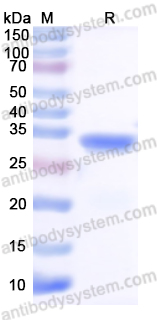Catalog No.
YHN33701
Expression system
E. coli
Species
Homo sapiens (Human)
Protein length
Met1-Arg270
Predicted molecular weight
32.23 kDa
Nature
Recombinant
Endotoxin level
Please contact with the lab for this information.
Purity
>90% as determined by SDS-PAGE.
Accession
Q9NQ88
Applications
ELISA, Immunogen, SDS-PAGE, WB, Bioactivity testing in progress
Form
Lyophilized
Storage buffer
Lyophilized from a solution in PBS pH 7.4, 0.02% NLS, 1mM EDTA, 4% Trehalose, 1% Mannitol.
Reconstitution
Reconstitute in sterile water for a stock solution. A copy of datasheet will be provided with the products, please refer to it for details.
Shipping
In general, proteins are provided as lyophilized powder/frozen liquid. They are shipped out with dry ice/blue ice unless customers require otherwise.
Stability and Storage
Use a manual defrost freezer and avoid repeated freeze thaw cycles. Store at 2 to 8°C for frequent use. Store at -20 to -80°C for twelve months from the date of receipt.
Alternative Names
Fructose-2,6-bisphosphatase TIGAR, TP53-induced glycolysis and apoptosis regulator, TIGAR, C12orf5, TP53-induced glycolysis regulatory phosphatase
Identification of TIGAR, a direct proteomic target associated with the hypoglycemic effect of Berberine. [YHN33701]
TIGAR attenuates intervertebral disc degeneration via autophagy-mediated Keap1 degradation and Nrf2 nuclear translocation to suppress nucleus pulposus pyroptosis., PMID:40345508
Blockade of TIGAR prevents CD8+ T cell dysfunction and elicits anti-AML immunity., PMID:40285889
Deciphering the Controversial Role of TP53 Inducible Glycolysis and Apoptosis Regulator (TIGAR) in Cancer Metabolism as a Potential Therapeutic Strategy., PMID:40277923
E2F8-induced GRPEL2 promoted colorectal cancer progression via targeting TIGAR., PMID:40269881
Sulforaphane downregulates mitochondrial TIGAR via inhibiting mitochondrial transmembrane assembly and LONP1/CASP3 axis causing apoptosis., PMID:40157290
The Impact of TP53-Induced Glycolysis and Apoptosis Regulator on Prognosis in Hepatocellular Carcinoma: Association with Tumor Microenvironment and Ferroptosis., PMID:40144470
m6A modification regulates cell proliferation via reprogramming the balance between glycolysis and pentose phosphate pathway., PMID:40140553
TIGAR alleviates cognitive impairment in rats with chronic cerebral hypoperfusion by suppressing oxidative stress and pyroptosis., PMID:40092124
TIGAR plays neuroprotective roles in MPP+/MPTP-induced Parkinson's disease by alleviating ferroptosis., PMID:40015596
TIGAR Suppresses ER Stress-Induced Neuronal Injury through Targeting ATF4 Signaling in Cerebral Ischemia/Reperfusion., PMID:39919831
Integrated TWAS, GWAS, and RNAseq results identify candidate genes associated with reproductive traits in cows., PMID:39809816
NSD2 mediated H3K36me2 promotes pulmonary arterial hypertension by recruiting FOLR1 and metabolism reprogramming., PMID:39798773
The Downregulation of CRIF1 Exerts Antitumor Effects Partially via TP53-Induced Glycolysis and Apoptosis Regulator Induction in BT549 Breast Cancer Cells., PMID:39682267
Identification of TIGAR, a direct proteomic target associated with the hypoglycemic effect of Berberine., PMID:39638076
Regulation of ROS signaling by TIGAR induces cancer-modulating responses in the tumor microenvironment., PMID:39636862
TIGAR coordinates senescence-associated secretory phenotype via lysosome repositioning and α-tubulin deacetylation., PMID:39633033
TIGAR relieves PCOS by inhibiting granulosa cell apoptosis and oxidative stress through activating Nrf2., PMID:39341450
Glutamine promotes the proliferation of intestinal stem cells via inhibition of TP53-induced glycolysis and apoptosis regulator promoter methylation in burned mice., PMID:39328365
Omnibus proteome-wide association study identifies 43 risk genes for Alzheimer disease dementia., PMID:39079537
Modeling of Intracellular Taurine Levels Associated with Ovarian Cancer Reveals Activation of p53, ERK, mTOR and DNA-Damage-Sensing-Dependent Cell Protection., PMID:38931171
Disruption of TIGAR-TAK1 alleviates immunopathology in a murine model of sepsis., PMID:38773142
TIGAR exacerbates obesity by triggering LRRK2-mediated defects in macroautophagy and chaperone-mediated autophagy in adipocytes., PMID:38686804
Cuscuta chinensis flavonoids alleviate ovarian damage in offspring female mice induced by BPA exposure during pregnancy by regulating the central carbon metabolism pathway., PMID:38537475
TIGAR reduces neuronal ferroptosis by inhibiting succinate dehydrogenase activity in cerebral ischemia., PMID:38494143
TIGAR Deficiency Blunts Angiotensin-II-Induced Cardiac Hypertrophy in Mice., PMID:38397106
Ferroptosis Plays a Pivotal Role in Activating and Modulating Specific Intracellular Signaling Pathways Integrated into the Therapeutic Management of Colorectal Cancer., PMID:39895914
Repeated radon exposure induced epithelial-mesenchymal transition-like transformation via disruption of p53-dependent mitochondrial function., PMID:38145089
Bioinformatics analysis and experimental validation reveal the anti-ferroptosis effect of FZD7 in acute kidney injury., PMID:38071893
Arsenic trioxide extends survival of Li-Fraumeni syndrome mimicking mouse., PMID:38030599
S1PR2 inhibition mitigates cognitive deficit in diabetic mice by modulating microglial activation via Akt-p53-TIGAR pathway., PMID:38011768
Impact of TP53-induced glycolysis and apoptosis regulator on malignant activity and resistance to ferroptosis in intrahepatic cholangiocarcinoma., PMID:37878531
Examining the biological pathways underlying clinical heterogeneity in Sjogren's syndrome: proteomic and network analysis., PMID:37657927
TP53 Induced Glycolysis and Apoptosis Regulator and Monocarboxylate Transporter 4 drive metabolic reprogramming with c-MYC and NFkB activation in breast cancer., PMID:37497753
Dimethyl fumarate ameliorates parkinsonian pathology by modulating autophagy and apoptosis via Nrf2-TIGAR-LAMP2/Cathepsin D axis., PMID:37315723
Activation of p53-regulated pro-survival signals and hypoxia-independent mitochondrial targeting of TIGAR by human papillomavirus E6 oncoproteins., PMID:37257253
TIGAR Protects Against Adenine-Induced Ferroptosis in Human Proximal Tubular Epithelial Cells by Activating the mTOR/S6KP70 Axis., PMID:37140263
TIGAR deficiency induces caspase-1-dependent trophoblasts pyroptosis through NLRP3-ASC inflammasome., PMID:37122710
CRIF1 siRNA-Encapsulated PLGA Nanoparticles Suppress Tumor Growth in MCF-7 Human Breast Cancer Cells., PMID:37108616
High Glucose Activates Prolyl Hydroxylases and Disrupts HIF-α Signaling via the P53/TIGAR Pathway in Cardiomyocyte., PMID:37048134
JMJD5 inhibits lung cancer progression by regulating glucose metabolism through the p53/TIGAR pathway., PMID:37043051
Sphingosine 1 phosphate lyase inhibition rescues cognition in diabetic mice by promoting anti-inflammatory microglia., PMID:36997095
Counteracting Colon Cancer by Inhibiting Mitochondrial Respiration and Glycolysis with a Selective PKCδ Activator., PMID:36982784
Identification of a Novel Protein-Based Prognostic Model in Gastric Cancers., PMID:36979962
Ameliorative effects of bilirubin on cell culture model of non-alcoholic fatty liver disease., PMID:36971910
TIGAR Protects Cochlear Hair Cells against Teicoplanin-Induced Damage., PMID:36943624
Modeling of Intracellular Taurine Levels Associated with Ovarian Cancer Reveals Activation of p53, ERK, mTOR and DNA-damage-sensing-dependent Cell Protection., PMID:36909636
TOMM20 as a Potential Prognostic Biomarker in Chordoma: Results From a High-Volume, Single-Center Study., PMID:36857736
IDH2 stabilizes HIF-1α-induced metabolic reprogramming and promotes chemoresistance in urothelial cancer., PMID:36637036
Inhibition of TIGAR Increases Exogenous p53 and Cisplatin Combination Sensitivity in Lung Cancer Cells by Regulating Glycolytic Flux., PMID:36555672
Insights from the p53 induced TIGAR protein 2 in the glycolytic pathway model., PMID:36518138

